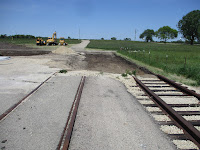... except YOU are there, thanks to the wonders of digital photography. Today's subjects are the 453 (natch!) and the 2872 (likewise!).
I started by moving the roof cables more or less into place on the roof, and verified that indeed every wire will connect to whatever it's supposed to. I also spent some time fastening down the trolley boards some more. Not much to see there.
I then took the roof fuse box to the shop. It's in pretty good shape as fuse boxes go, but the lower plate needed some patching with solid epoxy. Here you can see it setting up, with clamps.
After a few hours, it was ready for primer.
One unusual thing about these cars is that the roof fuse box is connected to the cable between the bus jumpers, so it only functions when power is flowing through the bus line. And we don't do that except as a last resort. Still, we need to have the fuse box provide protection.
And since it got rather warm up on the roof, I spent some time on the interior. The upper wall panels have loose paint which needs to be cleaned off by wire-wheeling. Before:
And after:
This takes some effort, but it will be worth it. All of our St. Louis 450's have similar problems with the interiors. Wire-wheeling can be tiring, but I find it works best to do it for a few minutes, then find something else to do and come back later.
Actually, the 453 probably has the best interior of the three cars. The ceiling in the main compartment is pretty good. The upper wall panels on the north side are peeling badly:
But on the south side it's OK. I can only think that this must be due to storage outside, with one side facing south and the other north. So the problems with the interiors might date back to the period from 1957-62, before the cars were acquired by Gerry Brookins.
I would think that the interior in the above picture would be acceptable for regular service, at least on a temporary basis.
On the other hand, the baggage racks are all pretty bad:
I'm thinking it will be best to remove the baggage racks, one or perhaps two at a time, and clean them up outside. At the same time it will be easier to strip and repaint the upper wall panels. I started loosening the machine screws that hold the first baggage rack in place, and it's certainly not impossible.
Meanwhile, work continued on the Met car, 2872.
Doug, who is usually part of the Barn 10 crew, came over to Barn 4 to needle-chip the exposed side sills on the Met car. I can't tell you how grateful Tim was for this help.
Tim, however, is disassembling one end of the car. You may guess at his general attitude:
Of course, if we had live recordings of his comments, the blog would be shut down by the censors.
And on the other hand, I suspect that if anyone other than Tim had started on this project, it would have been abandoned by now.
While the ends of the car are challenging, to say the least, the interior isn't too bad.
To follow this story to its exciting climax, you'll just have to tune in again. And again. And again.
Meanwhile, let's take a break and see what's happening out west where urban development is underway. Luckily, I ran into my old friend Al Choutka who explained exactly what's planned.
Here I'm standing near the current west end of Central Avenue, looking due west. At this point, the street will take an abrupt turn to the left.
Here I'm standing in about the same place, looking southwest. You can see straight ahead where the street will go. As for the street trackage, it will take an abrupt turn here. I think they will put in a piece of curved track on each side, and then follow that with several straight sections in parallel, until they get closer to the edge of the table.
Here I'm standing alongside the west wall of the MPB, looking southwest. The new North Western building will be rectangular, and set at an angle to the cardinal directions. I think you can make out its footprint. Running across the picture is a north-south "road" which will be removed. Between the MPB and the North Western building will be a drainage ROW.
We are open for regular operations all week now, of course. Today the 749 was providing service.
Well, that's all the exciting news we have for today. But there will be more, we can assure you.




















4 comments:
How many amps does it take to melt that fuse strip in the fuse box? Have any of those ever blown at IRM?
C Kronenwetter
Those are 700A fuses, and this box currently has two, so that's 1400A. We have blown 700A fuses in the past, but with our current state-of-the-art substation, I believe the substation will always drop faster than a fuse can melt. That's all to the good.
Does the open back of the box, then serve as sort of an arc chute? Is that an asbestos panel which lines the top of the box?
C Kronenwetter
Yes. When the fuse blows, the arc should be directed out the back, and the box is mounted tilted slightly downwards towards the roof. The top and bottom of the box are lined with asbestos, which gets painted with glyptal. When a fuse blows, usually the two ends both sort of crumple up into a little ball at each of the clamps. It's a rather crude design, but it must have worked reliably enough in regular service.
Post a Comment